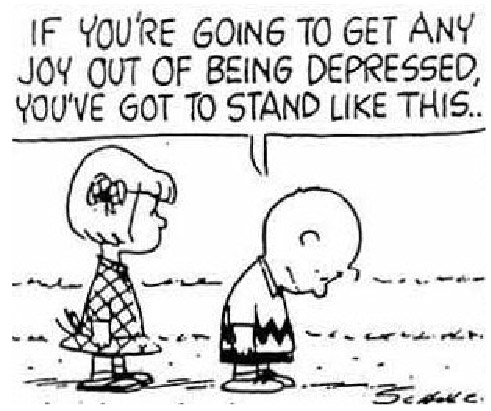Watching Charlie Brown made me so sad sometimes. Every time Lucy lifted the football just as he was about to kick it, I wished I could kick her in the head. And her 5 ₡ psychiatric help was worthless.
I can kid a little about depression because I experienced Dysthymia (a less severe but long-standing type of depression) in university and have helped friends and family members get through difficult down moments as well. But how can you tell the difference between the occasional bout of sadness and depression? I analyzed the attitudes and behaviors of 2, 105 people who took Queendom’s Depression Test, and who are currently being treated for depression. Here are the top 10 symptoms that they experienced:
1) 92% had irregular sleep patterns. Some had trouble falling asleep, some had trouble staying asleep, others found themselves sleeping more than usual.
2) 91% ruminated – they couldn’t stop obsessing about problems in their life.
3) 86% felt worn out, mentally and physically, and lacked energy, no matter how much rest they got.
4) 82% had persistent feelings of emptiness, often consisting of boredom or apathy.
5) 80% found themselves feeling overly-sensitive, perceiving insults or jabs in conversations with others when there weren’t any.
6) 76% constantly worried about what other people thought of them, especially when they did something embarrassing, made a mistake, or failed at something.
7) 76% had a “catastrophic thinking patterns.” They assumed the worst of even minor situations.
8) 76% had stomach pain for no identifiable reason. Remember, depression affects more than our mood.
9) 74% had trouble being resilient. Whenever something went wrong, they felt like they wouldn’t be able to pull themselves out of their rut.
10) 73% lacked motivation. They couldn’t seem to find the drive to finish projects they started.
This is by no means an exhaustive list, but if any of these symptoms seem familiar to you, seeking the advice of a professional is important. I honestly wish I had done the same, but thought that I could get through it on my own. It only made things more difficult.
If you’re not sure which therapy is right for you, I’ve got you covered. You can take a look at my two posts on different types of therapy:
The ABC’s of T-H-E-R-A-P-Y Part 1
The ABC’s of T-H-E-R-A-P-Y Part 2
Insightfully yours,
Queen D


